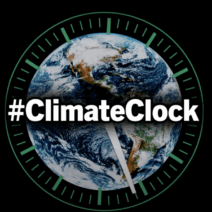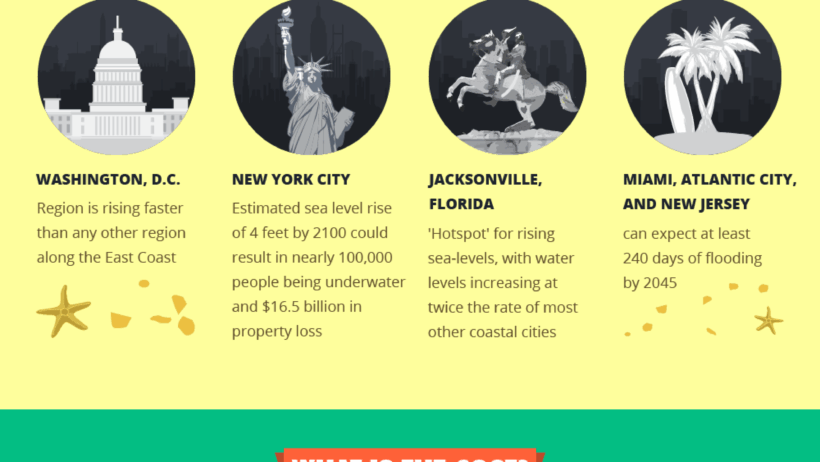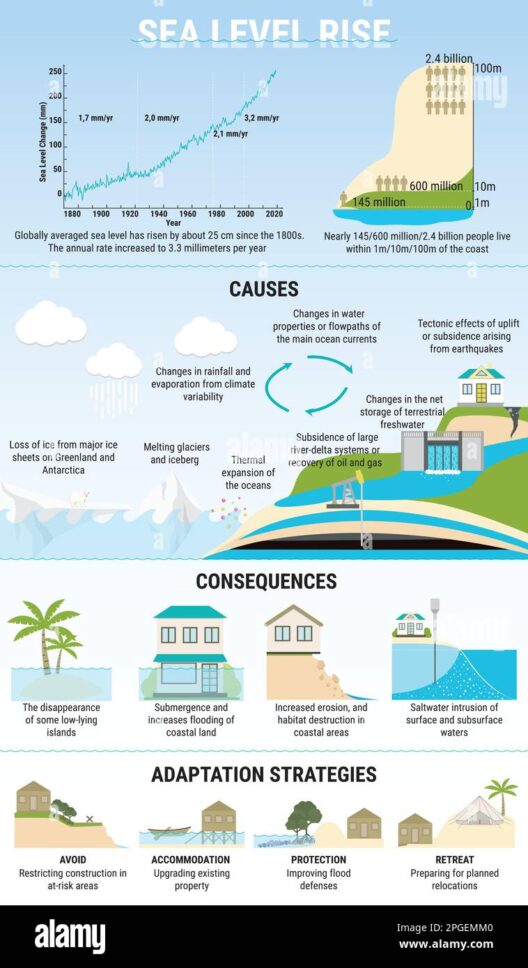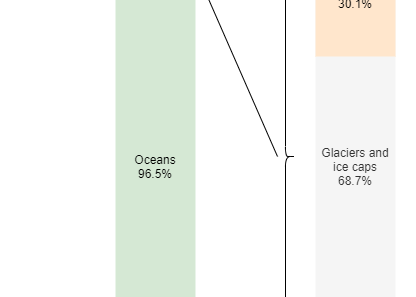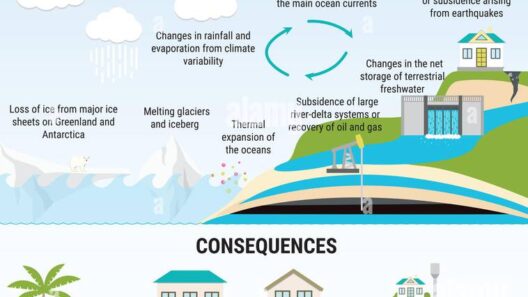Understanding the mechanisms driving rising sea levels is crucial for comprehending the broader implications of climate change on our planet. As the Earth’s temperature rises, the consequences manifest not only in fluctuating weather patterns but also in the persistent encroachment of ocean waters upon urban and rural landscapes alike. This article delves into the multifaceted causes behind rising sea levels, the evidence supporting these trends, and the prospective implications on ecology, human settlements, and infrastructure.
Climate change serves as the primary catalyst for sea-level rise through a combination of thermal expansion and melting ice. As the atmosphere warms, it leads to the expansion of ocean waters, a physical phenomenon scientifically termed thermal expansion. The Earth’s oceans absorb over 90% of the excess heat generated by greenhouse gas emissions, resulting in a measurable rise in water temperature. When a liquid warms, its particles move more vigorously, causing the liquid to occupy a larger volume. In the case of the ocean, even a modest temperature increase can culminate in significant alterations in sea level over time.
In tandem with thermal expansion, the melting of glaciers and polar ice sheets accelerates the influx of freshwater into the world’s oceans. The Greenland and Antarctic ice sheets encapsulate vast quantities of water, and small increases in temperature can incentivize their accelerated melting. Recent research indicates alarming rates of ice loss; for instance, Greenland is shedding ice at an average rate of around 280 billion tons annually, a stark contrast to historical baselines. These figures underscore the urgency of addressing climate change as they suggest that even a slight temperature rise could lead to heightened sea-level increases in the future.
A nuanced yet critical component of rising sea levels is the contribution of local factors such as land subsidence, tectonic activity, and regional oceanic circulation. Coastal cities often experience land subsidence due to natural geological processes combined with human activities such as groundwater extraction and the compression of sediment. As the ground sinks, the relative level of the sea rises, compounding the risks associated with global sea-level rise. Furthermore, variations in ocean currents and regional weather patterns can lead to localized sea-level changes, accentuating the concept that sea-level rise is not uniform but rather complex and multifaceted.
Additionally, the role of ice loss and its subsequent effects on sea-level fluctuations cannot be overstated. The Antarctic ice sheet, the world’s largest reservoir of freshwater, holds enough water to raise global sea levels by approximately 60 meters if it were to melt completely. While such a scenario is not projected to occur imminently, regional ice loss from West Antarctica is occurring at a concerning rate, feeding into the global sea-level rise. Studies show that the destabilization of ice shelves, which act as barriers to glacial flow, could expedite this phenomenon even further. As these ice shelves retreat and disintegrate, glaciers behind them are no longer held back, allowing them to make a swift descent into the ocean.
To grasp the implications of rising sea levels, one must consider the consequences for human populations and ecosystems. Estimates project that rising sea levels could displace millions of people worldwide by the end of the century. Coastal cities are particularly vulnerable and are likely to face increased flooding, erosion, and saltwater intrusion into freshwater sources. The very fabric of these urban environments is at risk, compelling governments and policymakers to devise adaptive strategies to mitigate these threats.
Furthermore, rising sea levels pose a significant threat to biodiversity. Coastal ecosystems such as mangroves, salt marshes, and coral reefs provide essential services, including habitat for countless marine species and protection against storm surges. As sea levels rise, these ecosystems are not only at risk of inundation but also face ocean acidification and temperature changes that inhibit their growth and resilience. The loss of these vital habitats can destabilize entire food webs, leading to declines in fish populations and, consequently, impacting human communities reliant on fisheries.
Scientific data robustly supports the case for urgent action. Satellite altimetry and tide gauge measurements have independently corroborated the trend of rising sea levels: the global average rate of increase has been measured at approximately 3.3 millimeters annually since the early 1990s. However, projection models suggest a potential acceleration in this rate if global temperatures continue to rise unabated. The Intergovernmental Panel on Climate Change (IPCC) warns that sea levels could rise between 0.3 to 1.1 meters by 2100, depending on greenhouse gas emission trajectories and ice sheet dynamics.
In conclusion, the phenomena of rising sea levels is multidimensional and spans a variety of causes, including thermal expansion, ice sheet melting, and local land subsidence. It poses grave threats to human settlements and ecosystems, necessitating proactive measures to mitigate its impacts. As public awareness grows and the urgency of action becomes increasingly apparent, it is imperative to engage in robust discussions on adaptation strategies and the necessity of reducing carbon emissions to avert further climate-related catastrophes. The time for action is now—to understand, to discuss, and to implement solutions that safeguard both our communities and our planet.


